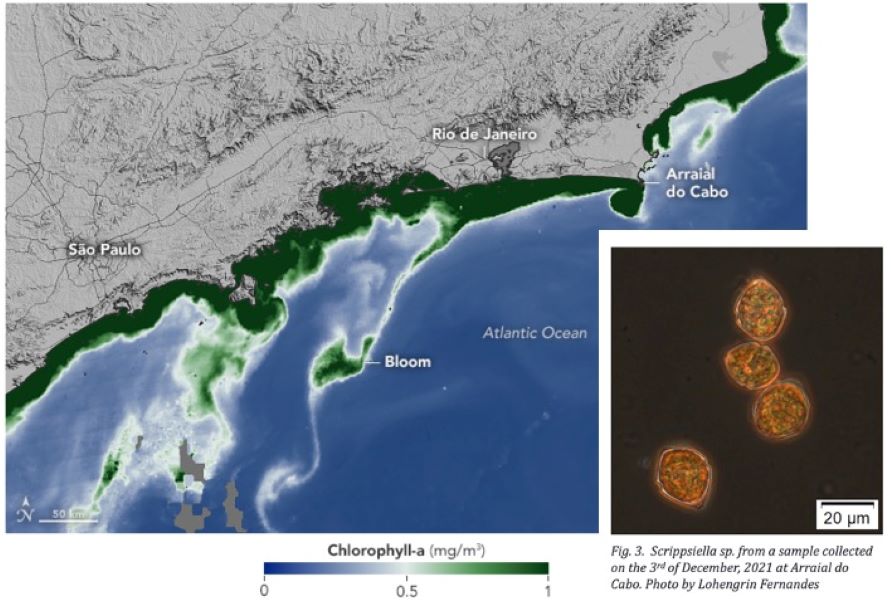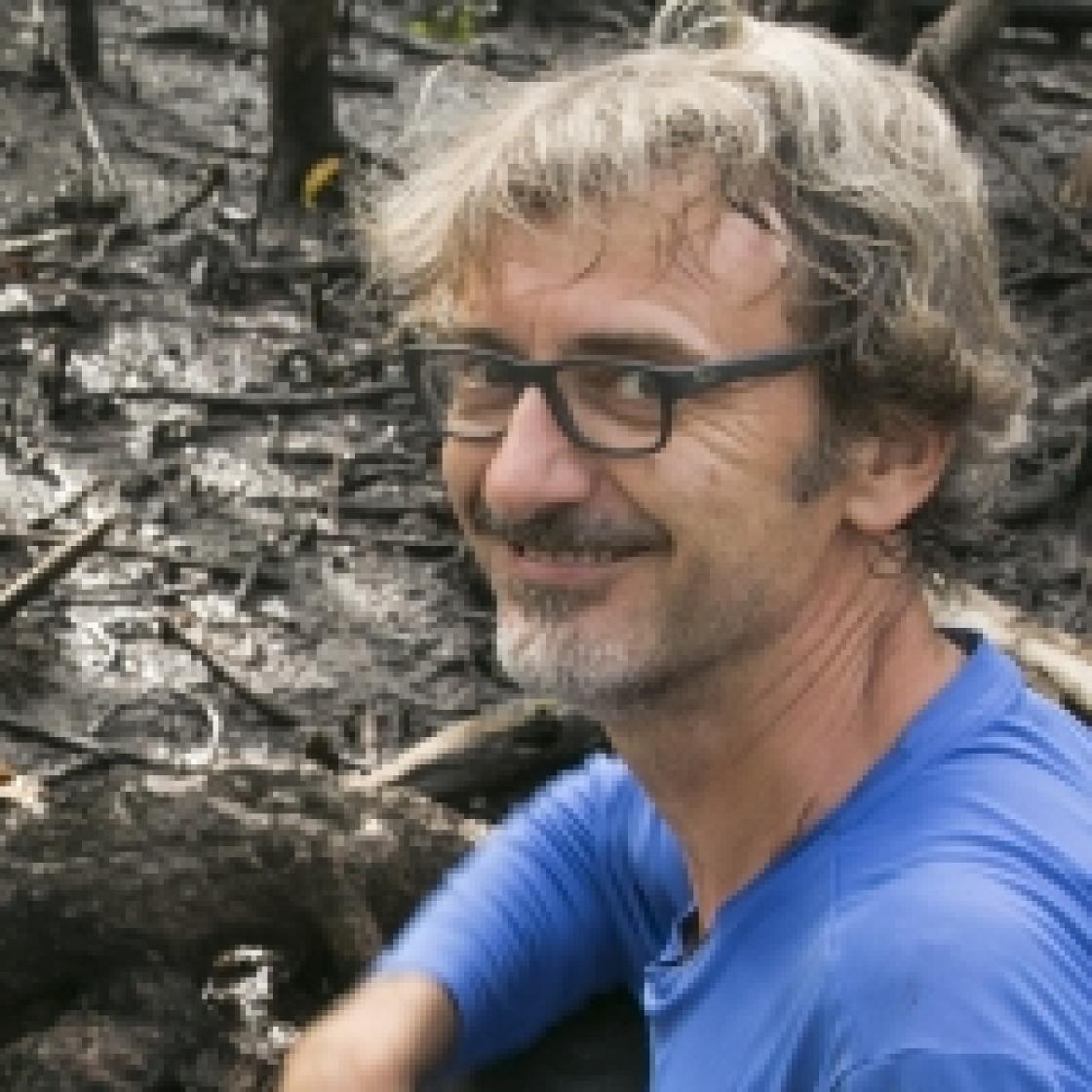Dans le cadre de l'IRP INEE France-Brésil VELITROP et du programme COFECUB (Comité Français d’Évaluation de la Coopération Universitaire et Scientifique avec le Brésil), Gleyci Moser (UERJ, Rio de Janeiro, Brésil) et Silvia Nascimento (UNIRIO, Rio de Janeiro, Brésil) donneront une conférence en deux parties sur le thème de « l'écologie du phytoplancton dans les régions côtières sous influence urbaine », vendredi 15 septembre à 14 h, en présentiel et en visio.
Contact BOREA : Gwenaël Abril, directeur de recherche CNRS, au MNHN Paris, coordinateur de l'IRP CNRS-INEE France-Brésil VELITROP "Vulnérabilité des Ecosystèmes Littoraux Tropicaux face à l'Eutrophisation".
Résumés :
Harmful algae blooms have occurred in Rio de Janeiro and are usually seen when heat waves hit the city. In November-December 2021, a widespread and long-lived event, that lasted for more than eight weeks and spread over more than 150 km occurred. This HAB event was monitored using remote sensing and water sampling by the beach. In November 2021, dark-red patches were seen along the beaches of the city of Rio and were dominated by the mixototrophic ciliate Mesodinium rubrum and the flagellate Tetraselmis sp., that grows inside Guanabara Bay and is exported to coastal waters. In early December 2021, coastal currents transported the bloom easterly towards the city of Arraial do Cabo, where the usually bright clear waters became dark brown. The bloom was then mainly composed by Tetraselmis sp. and a few species of dinoflagellates and one sample collected on that time was investigated using metabarcoding. Coastal waters of Rio are heavily eutrophic and are the place of a coastal upwelling that fertilizes surface waters and supports high primary production. Data on the 2021 exceptional HAB event will be presented, as well as a brief overview of other HAB species that occurr in the region.
Légende illustration : Distribution de la chlorophylle a dans la région côtière de Rio de Janeiro lors du dernier évènement de marée rouge en décembre 2021 (https://www.earth.com/image/red-tide-event-on-the-coast-of-rio-de-janeiro/) et l'espèce Scrippsiella sp. (Lange et al. 2022 An unprecedented harmful algae bloom in the beaches of Rio, Brazil, Harmful Algae News 70, 12 https://doi.org/10.5281/zenodo.6782899)
Lieu : Muséum national d'Histoire naturelle, Salle Baleine 1, Paris
Lien visio : https://zoom.us/j/95285578871Contact BOREA : Gwenaël Abril, directeur de recherche CNRS, au MNHN Paris, coordinateur de l'IRP CNRS-INEE France-Brésil VELITROP "Vulnérabilité des Ecosystèmes Littoraux Tropicaux face à l'Eutrophisation".
Résumés :
- Prof. Gleyci Moser, Universidade do Estado de Rio de Janeiro
“Phytoplankton biodiversity in eutrophic coastal systems in Rio de Janeiro- Brazil; Gaps in knowledge for international research cooperation”
The understanding of biodiversity has been one of the most important global challenges during the last 20 years; the maintenance of biological diversity affects both the functioning of ecosystems and the benefits and services they offer to human populations. In general, biodiversity is described in four hierarchical levels of biological organization (genetics, populations, communities, ecosystems). In turn, each of these levels considers three primary attributes of ecosystems: composition, structure, and function. EUTROBAYS project phocus on ecosystems responses to the eutrophication process on Rio de Janeiro urban bays (Guanabara and Ilha Grande-Sepetiba System) and adjacent continental shelf. The temporal β diversity, physiology and ecology of phytoplankton ranging from small eukaryotic to microplankton were featured throughout 10 years (2012 to 2022), compiling distinct projects, in Guanabara Bay (GB), a tropical eutrophicated coastal ecosystem. However, in Ilha Grande-Sepetiba System we are beginning the ecological and taxonomic studies based on the concept of morpho-species. During this period, in Guanabara Bay we work on: i. identify the specific diversity of phytoplankton based on the concept of morpho-species; ii. Establish monoclonal cultures to characterize the structural and ultrastructural morphology, as well as PUFA and PUA production of key species; iii. Sequence the 18s rDNA, 24S rDNA and ITS genes of key microalgae species; iv. Determine the spatial and temporal distribution of phytoplankton populations and v. Recognize functional groups of phytoplankton based on species grouping, physiological aspects and their relationship to measured abiotic variables. We foreseen the use of molecular approaches such as the next generation sequencing (NGS) to widen our knowledge on phytoplankton diversity in these systems, including the fraction of picophytoplankton (both prokaryotic and eukaryotic). There are gaps in knowledge concerning biological interactions among planktonic species in GB, such as the mixotrophic importance in the flux of carbon and nitrogen, parasitic diseases in phytoplankton and their role in bloom dynamics and omics.
- Prof. Silvia Nascimento, Universidade Federal do Estado de Rio de Janeiro (UNIRIO)
Harmful algae blooms have occurred in Rio de Janeiro and are usually seen when heat waves hit the city. In November-December 2021, a widespread and long-lived event, that lasted for more than eight weeks and spread over more than 150 km occurred. This HAB event was monitored using remote sensing and water sampling by the beach. In November 2021, dark-red patches were seen along the beaches of the city of Rio and were dominated by the mixototrophic ciliate Mesodinium rubrum and the flagellate Tetraselmis sp., that grows inside Guanabara Bay and is exported to coastal waters. In early December 2021, coastal currents transported the bloom easterly towards the city of Arraial do Cabo, where the usually bright clear waters became dark brown. The bloom was then mainly composed by Tetraselmis sp. and a few species of dinoflagellates and one sample collected on that time was investigated using metabarcoding. Coastal waters of Rio are heavily eutrophic and are the place of a coastal upwelling that fertilizes surface waters and supports high primary production. Data on the 2021 exceptional HAB event will be presented, as well as a brief overview of other HAB species that occurr in the region.
Légende illustration : Distribution de la chlorophylle a dans la région côtière de Rio de Janeiro lors du dernier évènement de marée rouge en décembre 2021 (https://www.earth.com/image/red-tide-event-on-the-coast-of-rio-de-janeiro/) et l'espèce Scrippsiella sp. (Lange et al. 2022 An unprecedented harmful algae bloom in the beaches of Rio, Brazil, Harmful Algae News 70, 12 https://doi.org/10.5281/zenodo.6782899)




